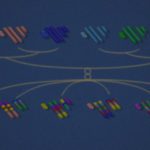Lien vers Pubmed [PMID] – 22163058
PLoS Negl Trop Dis 2011 Dec;5(12):e1421
BACKGROUND: Rift Valley fever virus (RVFV) causes disease in livestock and humans. It can be transmitted by mosquitoes, inhalation or physical contact with the body fluids of infected animals. Severe clinical cases are characterized by acute hepatitis with hemorrhage, meningoencephalitis and/or retinitis. The dynamics of RVFV infection and the cell types infected in vivo are poorly understood.
METHODOLOGY/PRINCIPAL FINDINGS: RVFV strains expressing humanized Renilla luciferase (hRLuc) or green fluorescent protein (GFP) were generated and inoculated to susceptible Ifnar1-deficient mice. We investigated the tissue tropism in these mice and the nature of the target cells in vivo using whole-organ imaging and flow cytometry. After intraperitoneal inoculation, hRLuc signal was observed primarily in the thymus, spleen and liver. Macrophages infiltrating various tissues, in particular the adipose tissue surrounding the pancreas also expressed the virus. The liver rapidly turned into the major luminescent organ and the mice succumbed to severe hepatitis. The brain remained weakly luminescent throughout infection. FACS analysis in RVFV-GFP-infected mice showed that the macrophages, dendritic cells and granulocytes were main target cells for RVFV. The crucial role of cells of the monocyte/macrophage/dendritic lineage during RVFV infection was confirmed by the slower viral dissemination, decrease in RVFV titers in blood, and prolonged survival of macrophage- and dendritic cell-depleted mice following treatment with clodronate liposomes. Upon dermal and nasal inoculations, the viral dissemination was primarily observed in the lymph node draining the injected ear and in the lungs respectively, with a significant increase in survival time.
CONCLUSIONS/SIGNIFICANCE: These findings reveal the high levels of phagocytic cells harboring RVFV during viral infection in Ifnar1-deficient mice. They demonstrate that bioluminescent and fluorescent viruses can shed new light into the pathogenesis of RVFV infection.






